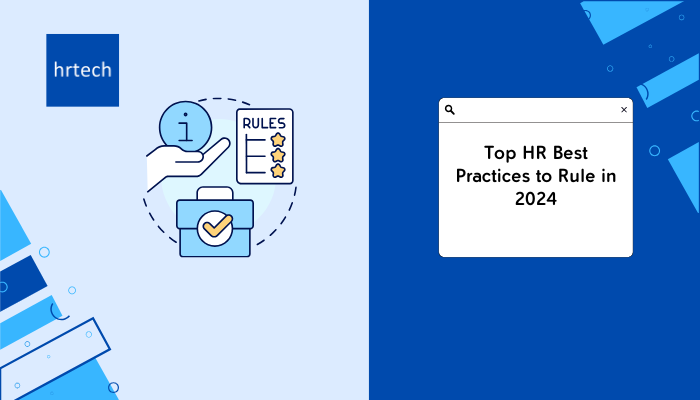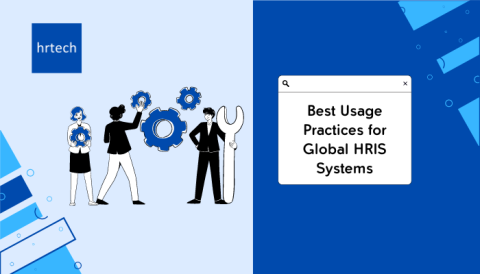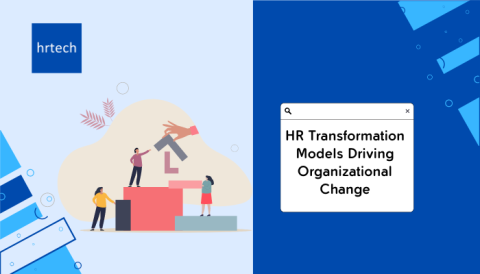Remember those old-fashioned workplaces with strict rules and policies that applied to everyone, no matter what? Those days are definitely gone! Today’s employees are looking for something different. They want flexibility, a sense of purpose in their work, and to feel like they truly belong in the company culture.
That means HR strategies need to change too. It’s not optional anymore – it’s essential! Here’s where things get exciting: HR best practices in 2025 are all about embracing innovative digital solutions.
Think about it!
Instead of relying solely on traditional methods, imagine having powerful software that can streamline all those time-consuming processes, gather valuable data to help you make informed decisions, and even empower your employees to take more control of their work experience.
We’re talking about tools that can automate repetitive tasks (like sorting through hundreds of resumes!), improve communication across teams with user-friendly platforms, and basically revolutionize the way you manage your people. Intrigued? Let’s explore how these practices can take your HR strategy to the next level and prepare you for the future of work!
Essential HR Best Practices:

Now that we’ve established the importance of staying ahead of the curve, let’s explore some of the essential HR best practices that will set you apart in 2025
Building a Loyal and Engaged Workforce:
In today’s competitive talent market, holding onto your top performers is crucial. Employees crave stability, and offering clear career paths and opportunities for growth demonstrates your commitment to their long-term success. This, in turn, fosters loyalty and reduces costly turnover. Tools like Logical Commander can provide valuable insights into employee sentiment and potential risks, allowing you to proactively address concerns and create a more engaging work environment.
Strategic Recruitment and Team Dynamics:
The days of mass recruitment are over. In 2025, it’s all about finding the right talent, not just filling positions. Invest in a rigorous hiring process that prioritizes skills, cultural fit, and alignment with your company goals. This not only saves time and resources but also creates a more cohesive and productive team.Modern applicant tracking systems (ATS) like recruiterpal, webbtree, manatal and many others can empower you to streamline this process by automating tasks, leveraging skills-based assessments, and providing valuable candidate insights.
Micromanagement is out. Today’s employees thrive in environments that empower them to take ownership and make decisions. By fostering self-managed teams, you unlock creativity, boost morale, and encourage a sense of accountability.
Motivating and Developing Your People:
Feeling valued is paramount for employee satisfaction. Transparent compensation tools like Compup can help you design a well-structured system that rewards performance and recognizes individual contributions. Regular salary reviews and clear bonus structures, facilitated by platforms like SalaryBoard, demonstrate your appreciation for your employees’ hard work, keeping them motivated and engaged.
The world of work is constantly evolving, and so should your employees’ skillsets. Investing in ongoing training and development programs ensures your team stays ahead of the curve. Embrace micro-learning platforms like Guvi to offer bite-sized, engaging learning modules. Complement this with comprehensive online courses from platforms like ArcLab to equip your employees with the necessary skills to excel in their roles. Consider mentorship programs to further empower continuous growth.
Emerging Trends in HR Practices:

The HR landscape is constantly evolving, and staying ahead of the curve is key to attracting and retaining top talent. Here, we’ll explore some of the hottest trends shaping HR practices in 2025
Embracing Change and Innovation:
The rise of remote work, the evolving nature of jobs, and the growing emphasis on work-life balance all necessitate change. Effective change management helps your organization navigate these transitions smoothly, minimizing disruption and maximizing employee buy-in.
Collaboration tools like WorkMate can be instrumental in this process by facilitating communication, fostering a sense of community among remote teams, and keeping everyone aligned with evolving goals and processes.
Leveraging Technology for Efficiency:
From automating tedious tasks like resume screening to providing data-driven insights for talent acquisition, AI and machine learning are revolutionizing HR. These technologies free up valuable time for HR professionals to focus on more strategic initiatives. Let’s explore some of the groundbreaking HR tech tools powered by AI and machine learning:
Resume screening: Platforms like Hirescore and Talemetry leverage AI to automate resume screening, filtering through a large pool of candidates to identify the most qualified individuals based on your defined criteria.
Predictive analytics: Tools like Greenhouse and BambooHR use machine learning to analyze data and predict future workforce needs, talent gaps, and potential flight risks. This allows for proactive talent acquisition strategies.
AI-powered chatbots: Chatbots powered by AI, like wysa and Olivia by Paradox, can streamline the candidate experience by answering frequently asked questions, scheduling interviews, and providing basic onboarding information.
Empowering Your Workforce:
Self-service portals allow employees to access information, update personal details, and manage benefits independently. This not only saves HR time but also fosters a sense of ownership and empowerment among employees.
These are just a few of the exciting trends shaping the future of HR. you can explore more tools at our marketplace and find your best fit.
Subscribe to our newsletter for the latest HR insights and best practices, or schedule a call with our team of HR experts to discuss how we can help you achieve your organizational goals.
Key HR Best Practices to Adopt:
Now that we’ve explored both established and emerging trends, let’s delve deeper into specific HR best practices you can implement to elevate your organization in 2025. These actionable steps will help you create a thriving work environment that attracts, retains, and empowers your top talent.
Building a Culture of Recognition and Appreciation:
Employees who feel valued are more likely to be engaged and productive. Implement a recognition program that celebrates achievements, both big and small. This could include public shout-outs, bonus structures, or personalized rewards.
Platforms like rewardful, compaas, TalentSpotify can help you streamline this process by offering features for creating custom recognition programs, sending personalized eCards and digital badges, and tracking employee achievements over time.
Enhancing Performance Management:
360 feedback system provides employees with multi-directional feedback from colleagues, managers, and even clients. This holistic approach helps identify areas for development and fosters a culture of continuous improvement. Platforms like HuddleUp streamline the 360 feedback process by facilitating anonymous feedback collection, generating insightful reports, and providing employees with personalized development plans.
You can also check surveymonkey, leaplearn and other tools available.
Fostering Collaboration and Knowledge Sharing:
Encourage knowledge sharing through mentorship programs, internal wikis, or brown bag lunch sessions. This not only fosters collaboration but also empowers employees to learn from each other.
Promoting Open Communication and Transparency:
Employees crave honesty and open communication from leadership. Share company updates, address concerns directly, and encourage open dialogue. This builds trust and fosters a sense of belonging.
Investing in Continuous Learning and Development:
As discussed earlier, continuous learning is crucial in today’s dynamic work environment. Offer training programs that equip employees with the skills they need to excel in their roles and stay ahead of the curve.
Enhancing Employee Engagement:
Regularly solicit feedback from employees through surveys, focus groups, or town hall meetings. By actively listening to your workforce, you can identify areas for improvement and create a more engaging work experience.
Maintaining Compliance and Safety:
Staying compliant with labor laws and regulations is not just ethical, it’s essential. Invest in HR resources and training to ensure you’re adhering to all legal requirements.
A safe work environment is paramount for employee well-being and productivity. Implement safety protocols, offer relevant training, and provide the necessary resources to create a hazard-free workplace.
Embracing Flexibility and Modern Tools:
Flexible work arrangements, such as remote work options or compressed workweeks, can significantly improve employee satisfaction and work-life balance.
Cloud-based HR software streamlines processes, automates tasks, and provides valuable data insights. This allows HR professionals to focus on more strategic initiatives and enhance overall operational efficiency.
Creating Synergies Among HR Practices:
It’s fantastic that you’re considering implementing these best practices! But, HR isn’t a siloed operation. For maximum impact, these practices should work together in a harmonious way.
Here’s where the concept of “bundles” comes in. Imagine a group of HR practices that complement and reinforce each other, creating a more significant impact than the sum of their parts.
For example, consider this bundle:
Offering ongoing training programs equips your employees with new skills.
Implementing a 360-degree feedback system helps identify areas for further development based on those skills.
Providing opportunities for knowledge sharing allows employees to learn from each other and further refine their newly acquired skills.
This bundled approach creates a learning ecosystem that empowers employees to continuously grow and excel in their roles.
People Factor:
At the heart of all successful HR strategies lies a people-centric approach. This means prioritizing your employee’s well-being, fostering a sense of belonging, and empowering them to reach their full potential.
Challenges in Implementing HR Best Practices:
While the benefits of these best practices are undeniable, implementing them effectively can come with its own set of challenges. Let’s explore some common hurdles and how to navigate them:
Bridging the Gap Between Theory and Practice:
Addressing Contradictions and Practical Challenges: Some best practices may seem contradictory on the surface. For instance, how do you offer employment security while also prioritizing selective hiring? The key lies in striking a balance. Focus on creating clear career paths and growth opportunities, while also implementing a rigorous recruitment process to ensure you’re bringing in the right talent for the long haul.
Examples of Challenges in Employment Security, Training, and Selective Hiring:
Employment Security: Providing clear career paths can be difficult in fast-paced industries with ever-evolving skill requirements. Solution: Offer training programs that equip employees with adaptable skillsets.
Training: Budgetary constraints or logistical challenges may limit access to training opportunities. Solution: Explore cost-effective online learning platforms or micro-learning opportunities.
Selective Hiring: Finding the “perfect” candidate can be time-consuming and lead to filling positions with readily available, but not necessarily ideal, candidates. Solution: Clearly define the essential skills and cultural fit required for the role. Invest in skills-based assessments to identify the best match.
Conclusion:
HR world is a dynamic one, and staying ahead of the curve is key to attracting and retaining top talent. By embracing the best practices outlined above, you can create a thriving work environment that empowers your workforce and fuels your organization’s success.
Here’s a quick recap for you:
Align HR with business goals.
Focus on building a loyal and engaged workforce.
Embrace new trends like AI and self-service portals.
Implement key practices for a positive employee experience.
Prioritize a people-centric approach.
Acknowledge and address challenges for successful implementation.
Ready to transform your HR function for the future of work? Explore the power of HR technology!
Hrtech Asia’s digital marketplace offers a curated selection of innovative HR software solutions designed to streamline your processes and empower your employees. Find the perfect fit for your organization’s needs and budget!
Start your free trial today and experience the HR transformation yourself!
By weaving this people-centric approach into every HR practice you implement, you’ll create a work environment where employees feel valued, motivated, and ready to contribute their best.




